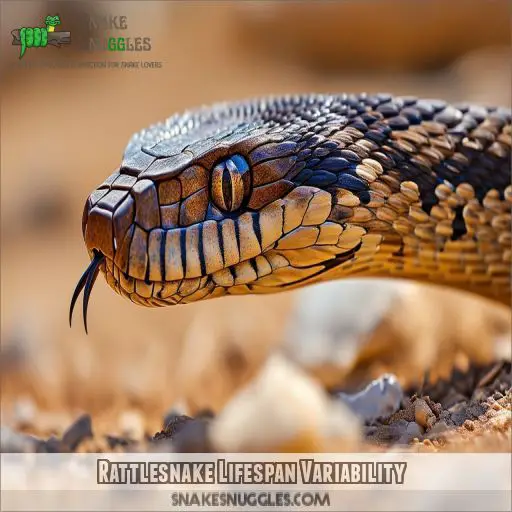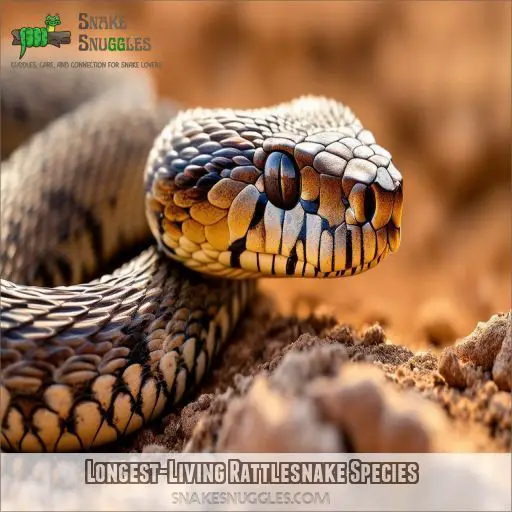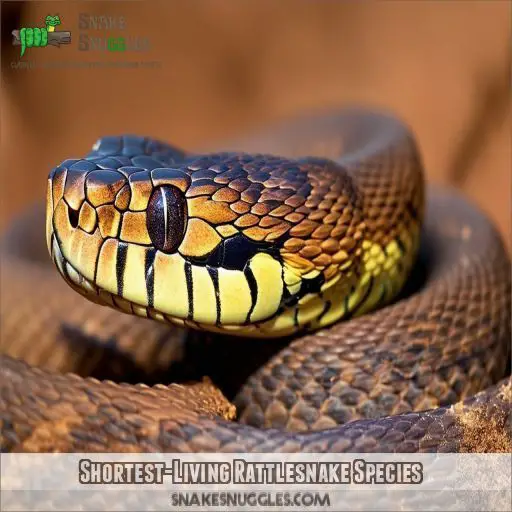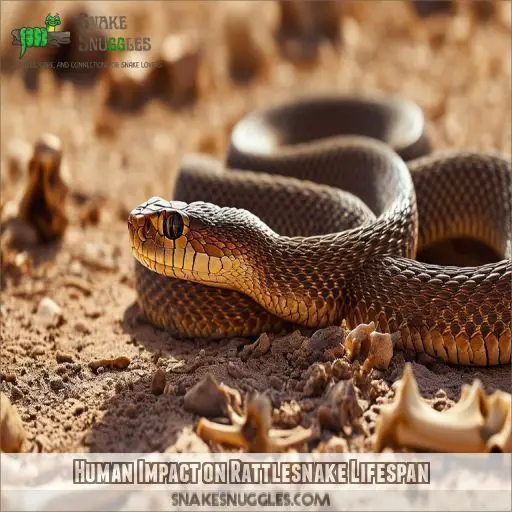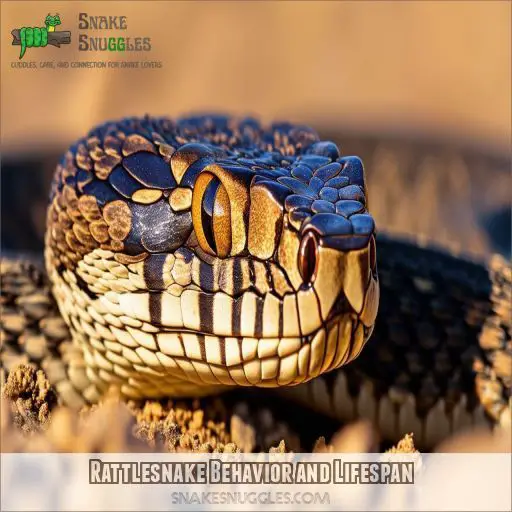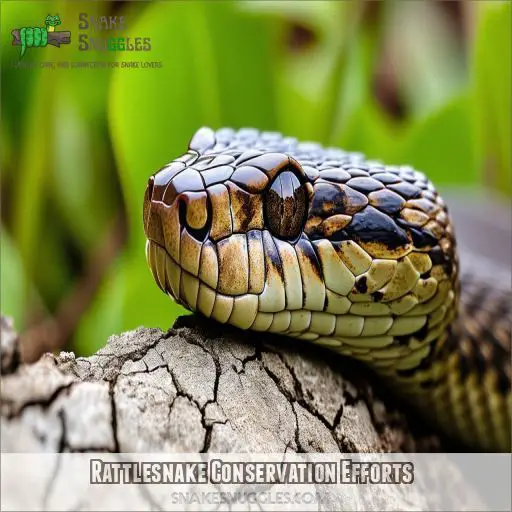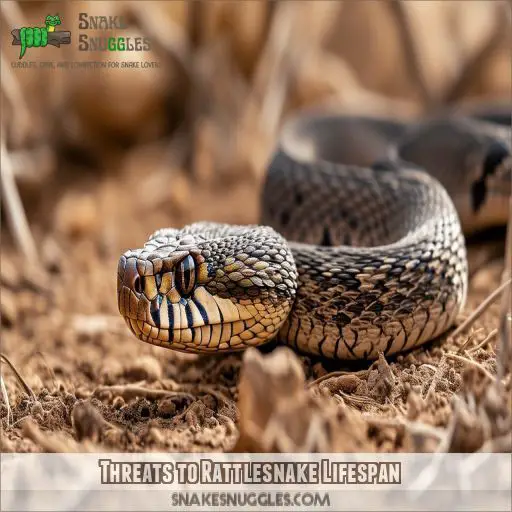This site is supported by our readers. We may earn a commission, at no cost to you, if you purchase through links.
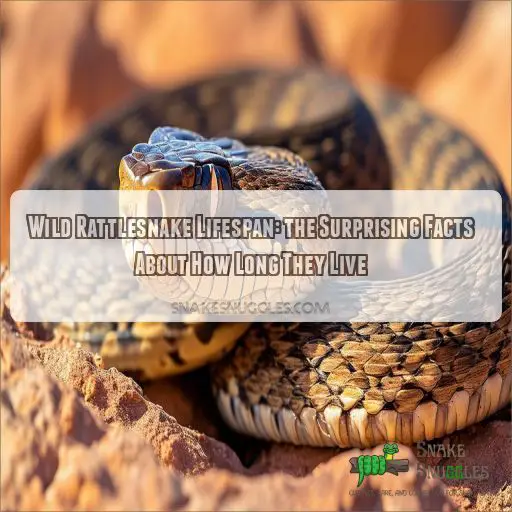
These creatures have a wide range of lifespans, from brief to potentially half a century.
Get ready to explore the wild rattlesnake’s world, uncovering their lifespan secrets and the factors that influence their time on Earth.
You’ll be surprised by the diversity and longevity of these enigmatic snakes.
Table Of Contents
- Key Takeaways
- Rattlesnake Lifespan Variability
- Factors Influencing Rattlesnake Lifespan
- Longest-Living Rattlesnake Species
- Shortest-Living Rattlesnake Species
- Human Impact on Rattlesnake Lifespan
- Rattlesnake Behavior and Lifespan
- Rattlesnake Conservation Efforts
- Threats to Rattlesnake Lifespan
- Frequently Asked Questions (FAQs)
- How old is a rattlesnake with 10 rattles?
- What is the average lifespan of a rattlesnake?
- How long does a person have after being bitten by a rattlesnake?
- How long does a western diamondback rattlesnake live?
- How long do rattlesnakes live in the wild?
- Which rattlesnakes live the longest?
- Which rattlesnakes have the shortest lifespan?
- How does human behaviour impact rattlesnake lifespan?
- What is the average lifespan of rattlesnakes?
- Conclusion
Key Takeaways
- Rattlesnakes can live for a surprisingly long time, with some species defying expectations and reaching ages of up to 20 years or more in the wild.
- The lifespan of a rattlesnake is influenced by a range of factors, including species, habitat, diet, and human threats. For example, the timber rattlesnake, found in North America’s grasslands and prairies, can live up to 20 years, while the Eastern Massasauga has an average lifespan of 18 years.
- Human impact, such as habitat destruction, unnecessary killings, and snake bites, poses a significant challenge to the longevity and survival of rattlesnakes. Conservation efforts focus on education and habitat preservation to address these issues.
- Rattlesnakes are solitary, strategic hunters with a range of behaviors that help them survive. Their hunting technique, for instance, involves striking their prey and then releasing it to crawl away and die before they feast.
Rattlesnake Lifespan Variability
The rattlesnake’s lifespan is a tale of variation, influenced by a mix of species, habitat, and the dangers that lurk in their environment. It’s a wild ride, and we’re just getting started.
Factors Influencing Rattlesnake Lifespan
There are several factors that influence the lifespan of rattlesnakes in the wild. Species, habitat, and diet all play a role, with some rattlesnakes living longer than others due to their specific characteristics and environments.
Snake Species Lifespan
Snake species play a significant role in the variation of rattlesnake lifespans. For example:
- Timber rattlesnakes can live up to 20 years in the wild.
- Eastern Diamondback rattlesnakes have a similar lifespan, also reaching up to 20 years.
- Prairie rattlesnakes share a comparable lifespan to timber rattlesnakes.
Habitat Impact
The habitat of rattlesnakes plays a key role in their lifespan, impacting their access to food and shelter, as well as their exposure to various threats. Rattlesnakes are found in diverse habitats, from deserts to wooded ecosystems across North and South America.
| Habitat Factors | Impact |
|---|---|
| Food Availability | A steady food source is essential for survival and can impact lifespan. |
| Shelter Options | Adequate shelter provides protection from predators and extreme weather conditions. |
| Habitat Destruction | Human activities, such as deforestation, can destroy rattlesnake habitats, reducing their lifespan. |
| Conservation Status | Proper habitat management and snake conservation efforts are vital to protect rattlesnakes and maintain their lifespan. |
Human Threats
Human impact and threats, such as fear and prejudice, can lead to unnecessary snake killings. Additionally, human interaction with wild snakes increases the risk of snake bites, which are dangerous for both parties involved.
Longest-Living Rattlesnake Species
Now, let’s shift our focus to the longest-living rattlesnake species.
Among the various rattlesnake species, the timber rattlesnake stands out for its impressive longevity. These snakes can live up to 20 years in the wild, which is quite remarkable when compared to other species.
Here’s a breakdown of some key facts about the timber rattlesnake and its lifespan:
- Prairie Rattlesnakes: These snakes have a similar lifespan to timber rattlesnakes, reaching ages of up to 20 years in the wild. They’re found in the grasslands and prairies of central North America, from southern Canada to northern Mexico.
- Eastern Diamondback Rattlesnakes: This species, native to the southeastern United States, can also live up to 20 years. They’re the largest rattlesnake species in the region and prefer longleaf pine savannas and other wooded habitats.
Shortest-Living Rattlesnake Species
While some rattlesnakes can live for a couple of decades, others have a much shorter lifespan. The Sidewinder rattlesnake, for instance, has a significant variation in lifespan between the sexes, with males averaging 13 years and females only around 5 years. Another species with a relatively shorter lifespan is the Eastern Massasauga, which has an average lifespan of 18 years.
Here’s a table comparing the lifespans of these two species:
| Species | Male Lifespan | Female Lifespan | Average Lifespan |
|---|---|---|---|
| Sidewinder Rattlesnake | 13 years | 5 years | N/A |
| Eastern Massasauga | N/A | N/A | 18 years |
The lifespan variation within rattlesnake species is influenced by a variety of factors, including their specific habitat and diet, as well as the unique challenges they face in the wild.
Human Impact on Rattlesnake Lifespan
While rattlesnakes face various natural threats, including predators like mountain lions, human impact poses a significant challenge to their lifespan and overall survival.
Human fear and prejudice against snakes can lead to unnecessary killings, often driven by a lack of understanding about the importance of these creatures in the ecosystem. This fear can also result in snake bites, as people may unintentionally interact with wild snakes.
To address these issues, conservation efforts are focused on educating the public about snake behavior and their ecological significance. By increasing awareness, the hope is that people will learn to respect rattlesnakes and appreciate their role in maintaining a healthy balance in nature.
Additionally, habitat loss due to human population growth and land conversion poses a severe threat to rattlesnakes. The alteration and destruction of their natural habitats, such as longleaf pine savannas, directly impact the survival of these snakes and other wildlife that depend on these ecosystems.
As a result, rattlesnakes face shorter lifespans and declining populations. Conservation festivals have replaced rattlesnake roundups to educate communities and promote the protection of these misunderstood creatures.
Rattlesnake Behavior and Lifespan
Rattlesnake behavior and lifespan have a lot to offer in terms of understanding these wild animals. Known as Crotalus Atrox or pit vipers, these creatures display a range of behaviors that affect how long they live. The Mojave rattler, for instance, shows the adaptability of this species.
Rattlesnakes are solitary creatures, good at ambushing their prey. They’re also known to bask in the sun to regulate their body temperature and seek shelter in various structures when faced with harsh weather conditions. Their hunting technique involves striking their prey and then releasing it to crawl away and die before they consume it. This behavior shows their strategic nature.
The lifespan of rattlesnakes varies, and while they can live up to 25 years in captivity, their time in the wild is often shorter due to various factors and threats.
Rattlesnake Conservation Efforts
Conservation efforts for rattlesnakes are important to protect these fascinating creatures and help them survive in the long run.
The focus is on preserving their habitats, educating the public, and raising awareness about the importance of rattlesnakes in North and South America’s natural history.
Conservationists work tirelessly to restore and maintain the diverse ecosystems rattlesnakes call home, from deserts to wooded areas.
This includes proper habitat management, such as prescribed fires in longleaf pine savannas, to provide safe spaces for rattlesnakes to live, reproduce, and forage.
Additionally, educating communities about rattlesnake behavior and their ecological significance is a key component of conservation efforts.
By dispelling fears and misconceptions, we can foster a better understanding of these snakes and promote peaceful coexistence.
Conservation festivals, research initiatives, and community engagement all play a significant role in protecting rattlesnakes and ensuring their longevity in the wild.
Threats to Rattlesnake Lifespan
Unfortunately, rattlesnakes face a variety of threats that impact their lifespan. One significant threat is habitat loss due to human population growth. As people expand their settlements, the natural habitats of rattlesnakes, such as longleaf pine savannas, are destroyed or altered, leaving these snakes without a safe place to live, reproduce, and forage.
Another danger comes from the illegal snake trade and poaching. The snakeskin trade, for example, encourages the collection of rattlesnakes, often leading to significant mortality rates. Additionally, the illegal gassing of gopher tortoise burrows, where snakes seek refuge and hibernate, contributes to their decline.
To make matters worse, road mortality poses a serious risk as rattlesnakes attempt to cross roads. On top of that, diseases and parasites can also take a toll on their health and survival.
These threats underscore the importance of conservation efforts to protect rattlesnakes and their habitats. By addressing these challenges, we can help make sure these fascinating creatures survive in the long run.
Frequently Asked Questions (FAQs)
How old is a rattlesnake with 10 rattles?
It’s hard to say exactly how old a rattlesnake with 10 rattles is, but we can make an estimate. Rattlesnakes add a new rattle each time they shed their skin, and they can live for 25 years or more in the wild. So, a rattlesnake with 10 rattles could be around 10 to 25 years old, or possibly older.
What is the average lifespan of a rattlesnake?
The average rattlesnake lifespan is 10 to 25 years, but some live as short as 10 years or as long as 25 years. The speckled rattlesnake lives for 10 to 15 years, while the Mojave rattlesnake can live for 24 years.
How long does a person have after being bitten by a rattlesnake?
If you’re bitten by a rattlesnake, it’s imperative to get to a hospital within 30 minutes to receive antivenom treatment. This can reduce the risk of severe complications or death. Without treatment, organ failure and death can occur within two to three days.
How long does a western diamondback rattlesnake live?
Western diamondback rattlesnakes have a lifespan of fifteen to twenty years. These snakes are the real deal—they’re in it for the long haul.
How long do rattlesnakes live in the wild?
Rattlesnakes typically live between 10 and 25 years in the wild, but this can vary depending on the species, habitat, and diet.
Which rattlesnakes live the longest?
The Timber, Prairie, Eastern Diamondback, Western Diamondback, and Pygmy rattlesnakes can live up to 20 years.
Which rattlesnakes have the shortest lifespan?
The sidewinder rattlesnake has the shortest lifespan, with males living to around 13 years and females only living to around 5 years.
How does human behaviour impact rattlesnake lifespan?
Human behaviour can impact rattlesnake lifespan in several ways. Fear and prejudice against rattlesnakes can lead to people killing them. Snakes in captivity often live longer than those in the wild due to fewer threats. Human activities, such as rapid habitat destruction, also pose a threat to rattlesnake populations.
What is the average lifespan of rattlesnakes?
Rattlesnakes typically live between 10 and 25 years, depending on various factors. For instance, a timber rattlesnake in the wild might live up to 20 years, while a sidewinder rattlesnake (male) averages 13 years.
Conclusion
Clearly, the wild rattlesnake lifespan is a complex and varied topic.
You now know that these snakes can live for surprisingly long periods, with some species exceeding expectations.
Understanding the factors influencing their longevity, from habitat to human threats, is essential for conservation efforts.

